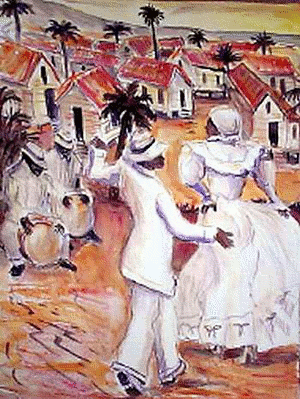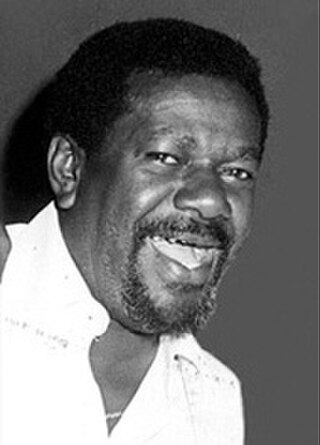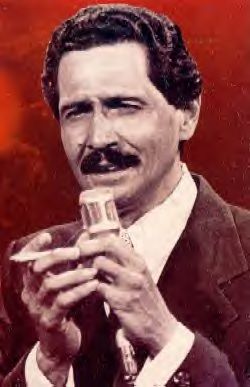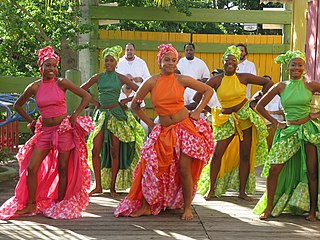Danny Rivera is a singer and songwriter born in San Juan whose career spans nearly 50 years. He is well known in Puerto Rico for his political activism. In 2008, Rivera acquired Dominican Republic citizenship. After 12 years of work, Danny Rivera and Nelson González in 2014 finished work putting new life into the classical bolero - in Spanish. Rivera and González Hit the Heart of the Latin American Song Book on Obsesión

The Music of Puerto Rico has evolved as a heterogeneous and dynamic product of diverse cultural resources. The most conspicuous musical sources of Puerto Rico have primarily included European, Indigenous, and African influences, although many aspects of Puerto Rican music reflect origins elsewhere in the Caribbean. Puerto Rican music culture today comprises a wide and rich variety of genres, ranging from essentially native genres such as bomba, danza, and plena to more recent hybrid genres such as salsa, Latin trap and reggaeton. Broadly conceived, the realm of "Puerto Rican music" should naturally comprise the music culture of the millions of people of Puerto Rican descent who have lived in the United States, especially in New York City. Their music, from salsa to the boleros of Rafael Hernández, cannot be separated from the music culture of Puerto Rico itself.

Plena is a genre of music and dance native to Puerto Rico.

Bomba is both a traditional dance and musical style of Puerto Rico. Its origins are rooted in the island's history of African slavery but today has evolved into a community expression of Puerto Rican culture. While Bomba can be used as the generic name for a number of rhythms, it is truly about a creative, interactive relationship between dancers, percussionists and singers. Today it's practiced as a communal activity in its centers of origin in Loíza, Santurce, Mayagüez and Ponce. Also, Puerto Rican migrants have brought the tradition to some parts of the U.S. mainland.

Juan Morel Campos, sometimes erroneously spelled Juan Morell Campos, was a Puerto Rican composer, considered by many to be responsible for taking the genre of danza to its highest level. He composed over 550 musical works before he died unexpectedly at age 38.

The Nuyorican movement is a cultural and intellectual movement involving poets, writers, musicians and artists who are Puerto Rican or of Puerto Rican descent, who live in or near New York City, and either call themselves or are known as Nuyoricans. It originated in the late 1960s and early 1970s in neighborhoods such as Loisaida, East Harlem, Williamsburg, and the South Bronx as a means to validate Puerto Rican experience in the United States, particularly for poor and working-class people who suffered from marginalization, ostracism, and discrimination.

Rafael Antonio Cortijo was a Puerto Rican musician, orchestra leader, composer and percussion instrument craftsman.

Gilberto Monroig was a Puerto Rican guitarist, and singer of boleros.

Sylvia Del Villard, was an actress, dancer, choreographer and Afro-Puerto Rican activist.
Mon Rivera is the common name given to two distinct Puerto Rican musicians, namely Monserrate Rivera Alers and his oldest son, Efraín Rivera Castillo, . This article refers mainly to Efraín Rivera Castillo, a popular band leader known in salsa, plena and Latin jazz circles.

Afro-Puerto Ricans are Puerto Ricans who self-identify as Black. The history of Puerto Ricans of African descent begins with free African men, known as libertos, who accompanied the Spanish Conquistadors in the invasion of the island. The Spaniards enslaved the Taínos, many of whom died as a result of new infectious diseases and the Spaniards' oppressive colonization efforts. Spain's royal government needed laborers and began to rely on African slavery to staff their mining and fort-building operations. The Crown authorized importing enslaved West Africans. As a result, the majority of the African peoples who entered Puerto Rico were the result of the Atlantic slave trade, and came from many different cultures and peoples of the African continent.

Rafael Cepeda Atiles, recognized as "The Patriarch of the Bomba and Plena", was the patriarch of the Cepeda family, known internationally as ambassadors of Afro-Puerto Rican folk music.

A parranda is a Puerto Rican music tradition that takes place in Puerto Rico during the Christmas holiday season. Parrandas are social events that feature traditional Puerto Rican music, food, and drinks. The traditional events have been likened to Christmas caroling, but the contents of the songs are secular rather than religious. They are sometimes carried out in the evening, but most traditionally occur in the night, even into the wee hours of the morning. The songs sung are almost exclusively aguinaldos. In this tradition, people go to their friends' or relatives' homes "singing songs, eating pasteles and arroz con dulce, sipping coquito and picking up people along the way" who then join in to proceed to the next home.
Viento de Agua is a contemporary bomba and plena band, created in New York City in 1997. Bomba and plena are musical genres within the Afro-Puerto Rican tradition. Their first album, De Puerto Rico al Mundo, was selected among the Top 10 Latin albums of the year by The New York Times.

Puerto Ricans in Chicago are people living in Chicago who have ancestral connections to the island of Puerto Rico. They have contributed to the economic, social and cultural well-being of Chicago for more than seventy years.
Epifanio “Fano” Irizarry Jusino was a Puerto Rican oil canvas painter, draftsman, and art professor from Ponce, Puerto Rico. He exposed Costumbrismo practices of his native Puerto Rico, including bomba and plena dances, cockfighting and carnivals. During his professional lifetime, he exhibited in Puerto Rico, the United States as well as Europe, some of which were solo, and he was the winner of various prestigious awards.

Cachi Cachi music, also spelled Kachi Kachi, Kachi-Kachi and Katchi-Katchi, is a term that was coined to refer to music played by Puerto Ricans in Hawaii, after they migrated to Hawaii in 1901.
Juan Ramírez Rivera, better known as Juanchín Ramírez, was a Puerto Rican trumpeter, bandleader and composer. He was a founding member of the Septeto Puerto Rico and the Grupo Aurora, as well as a member of the Noro Morales orchestra, also playing with Boro Milián, Rafael Hernández, Machito and others. He is best known for his popular compositions, primarily guarachas such as "Anabacoa", recorded by Beny Moré and Arsenio Rodríguez among others, and also "Plena española", made famous by Billo's Caracas Boys.

The Festival de Bomba y Plena de San Antón, is an annual celebration held in Ponce, Puerto Rico, as an extravaganza celebration of Bomba and Plena music genres and the traditions of Ponce's barrio San Antón. The celebration lasts 10 days and it ends on a Sunday. It is generally held in July but sometimes in November.
Héctor René "Tito" Matos Otero was a Puerto Rican percussionist. He played the requinto drum, a key instrument in plena music. He was one of the founders of Viento de Agua. According to the Smithsonian Institution, he is considered “one of the best requinto players of his generation.”











